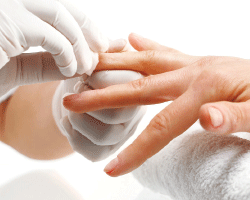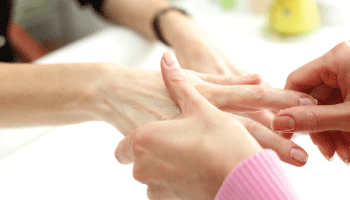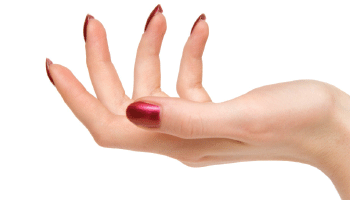The history of the manicure can be dated back to over 3,000 years ago when ancient Babylonian and Egyptian men and women used stained fingernails to signify their wealth. In addition to staining their fingernails black or red, they also used many rich oils to care for their fingernails.
1. Today, manicures have increasingly become a fashion statement and there are a variety of manicure procedures to choose from, including a basic manicure, French manicure, gel manicure, and paraffin manicure.
 2. Don't skip the consultation. Like skin care treatments, manicures should be preceded by a consultation. These pre-appointment sessions are important not only for the client, but also the professional and allow the professional to explain which services they think best suit the client and why. During the consultation, observe the client's hands and fingernails and calmly point out any signs of infection or skin conditions. Should there be any concern, kindly recommend that the client visits a physician to assist them with the problem. If the client is unable to get a service that day due to a condition, it would be a nice gesture to offer a discounted voucher for another day when their condition has been resolved. Most clients enjoy a special and offering them a discount shows them that even though they cannot get a service at the present time, they can always look forward to being pampered at a discounted price on another occasion.
2. Don't skip the consultation. Like skin care treatments, manicures should be preceded by a consultation. These pre-appointment sessions are important not only for the client, but also the professional and allow the professional to explain which services they think best suit the client and why. During the consultation, observe the client's hands and fingernails and calmly point out any signs of infection or skin conditions. Should there be any concern, kindly recommend that the client visits a physician to assist them with the problem. If the client is unable to get a service that day due to a condition, it would be a nice gesture to offer a discounted voucher for another day when their condition has been resolved. Most clients enjoy a special and offering them a discount shows them that even though they cannot get a service at the present time, they can always look forward to being pampered at a discounted price on another occasion.
3. Sanitation is a must. When giving a manicure, sanitation is mandatory. Both the professional and the client should sanitize and wash their hands with an  antibacterial soap and dry off with a clean towel. All of the equipment and tools needed for the manicure should be disinfected before, during, and after each use and arranged for easy access.
antibacterial soap and dry off with a clean towel. All of the equipment and tools needed for the manicure should be disinfected before, during, and after each use and arranged for easy access.
 4. Start with a blank canvas. When giving a manicure, it is important to remove any fingernail polish from the client's fingernails with a non-acetone polish remover and a cosmetic pad, being sure to wipe towards the free edge of the fingernail. During this time, share other services with them that they may enjoy and encourage them to relax and enjoy the pampering.
4. Start with a blank canvas. When giving a manicure, it is important to remove any fingernail polish from the client's fingernails with a non-acetone polish remover and a cosmetic pad, being sure to wipe towards the free edge of the fingernail. During this time, share other services with them that they may enjoy and encourage them to relax and enjoy the pampering.
5. Shape it up! Every client has a unique preference as to the shape of their fingernails. Always inquire about fingernail shape before filing or cutting. File the client's fingernails to their requested shape by using an emery board in one direction. Gently use strokes from the right to the left and then to the center. Do not file the fingernails in a sawing motion; bevel any rough edges in order to prevent future damage to the free edge layers.
 6. Cuticle care. Cuticles are a specialized type of epidermis that connects the finger's skin with the nail and provides a barrier that protects against bacteria and infection. During a manicure, apply cuticle remover around the cuticles of each fingernail and gently massage the area in a circular motion. To easily remove any excess residue from the client's fingernails, the professional should soak the client's hands for approximately three minutes in a clear manicure bowl filled with lukewarm water. The professional may also add a few drops of hand soap to the water. Using a cuticle pusher, gently push back the cuticles; they should not be pushed back too far, however, because it can damage the fingernail and impede growth. If necessary, cuticle clippers can be used, but take care to avoid cutting the client at all costs. Clean the excess cuticle from the fingernail plate and dispose of them properly.
6. Cuticle care. Cuticles are a specialized type of epidermis that connects the finger's skin with the nail and provides a barrier that protects against bacteria and infection. During a manicure, apply cuticle remover around the cuticles of each fingernail and gently massage the area in a circular motion. To easily remove any excess residue from the client's fingernails, the professional should soak the client's hands for approximately three minutes in a clear manicure bowl filled with lukewarm water. The professional may also add a few drops of hand soap to the water. Using a cuticle pusher, gently push back the cuticles; they should not be pushed back too far, however, because it can damage the fingernail and impede growth. If necessary, cuticle clippers can be used, but take care to avoid cutting the client at all costs. Clean the excess cuticle from the fingernail plate and dispose of them properly.
 7. Pamper away. Do not forget to pamper the client during their manicure! Professionals can use a lotion or any type of aromatherapy oil to gently massage the client's hands and fingers, replenishing their skin and cuticles. Lotions with a mild or fruity fragrance can add a feminine touch to the experience. Massages with lotions or oils are also recommended because the client will notice a difference in their appearance before the service is even complete.
7. Pamper away. Do not forget to pamper the client during their manicure! Professionals can use a lotion or any type of aromatherapy oil to gently massage the client's hands and fingers, replenishing their skin and cuticles. Lotions with a mild or fruity fragrance can add a feminine touch to the experience. Massages with lotions or oils are also recommended because the client will notice a difference in their appearance before the service is even complete.
8. Clean the nails. Fingernail lacquer or polish will not adhere to any oily surface, so be sure to wipe off the oil and moisture from the fingernail plate  before applying the base coat. A thin layer of base coat should always be applied before painting the client's fingernails with their desired polish color. Base coat is important because it acts as an adhesive to the fingernail plate and a bonding agent with the fingernail polish.
before applying the base coat. A thin layer of base coat should always be applied before painting the client's fingernails with their desired polish color. Base coat is important because it acts as an adhesive to the fingernail plate and a bonding agent with the fingernail polish.
9. Don't shake it. Before applying the fingernail polish, the professional should roll the bottle of polish in the palm of their hands; avoid shaking the bottle as that action may result in air bubbles that can transfer to the fingernail plate during application. Always apply a thin layer of polish and use a stroking method from the cuticle to the free edge, starting from the center of the fingernail. Three strokes should be enough to evenly distribute on each fingernail.

10. Dry time. Allow the polish to dry between coatings for a smooth finish. Furthermore, be sure to seal the polish with a top coat or sealant after allowing the last coat of colored polish to thoroughly dry. Do not rush to apply top coat if the enamel has not properly dried as failure to do so can result in smudging of the polish and may also cause peeling in certain areas from the fingernail plate.
 Kerlisha "Kerly" Munroe, an INM educator, has worked as a professional nail artist for many years, expressing hers and her clients' personalities on the tiniest of canvases through intricate nail art and design. Munroe uses social media to share her love of her craft and her positive outlook has helped her succeed in business and life, in spite of living with sickle cell anemia. Her expertise and passion for nails has made her an important part of INM's team.
Kerlisha "Kerly" Munroe, an INM educator, has worked as a professional nail artist for many years, expressing hers and her clients' personalities on the tiniest of canvases through intricate nail art and design. Munroe uses social media to share her love of her craft and her positive outlook has helped her succeed in business and life, in spite of living with sickle cell anemia. Her expertise and passion for nails has made her an important part of INM's team.
Want to read more?
Subscribe to one of our monthly plans to continue reading this article.